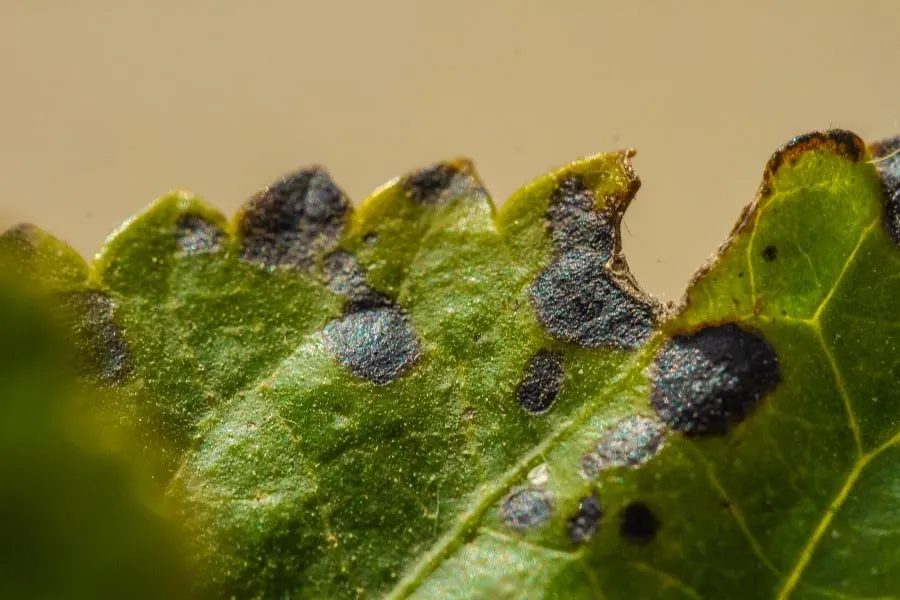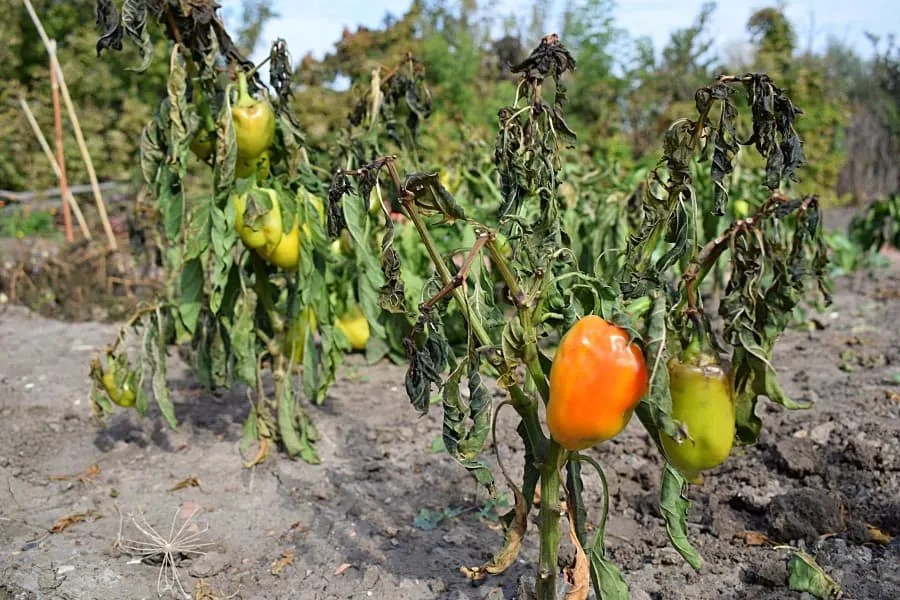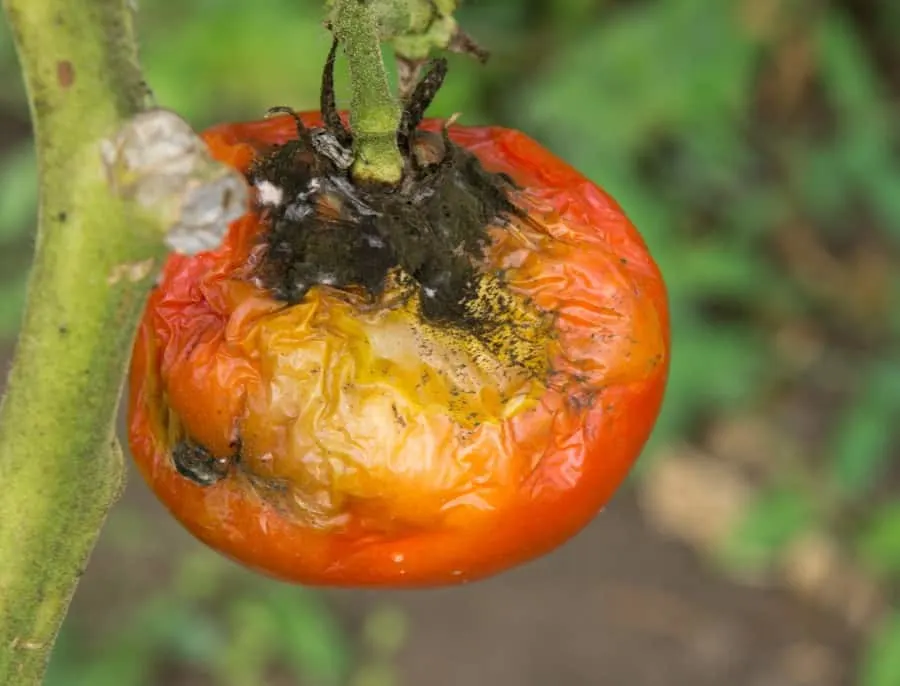Pepper plants can develop black spots on their fruits, leaves and stem for a variety of reasons. The good news is that seeing black spots on your pepper plant is not always a cause for concern.
Some pepper plants, like Jalapeños or Bells, might develop black spots as a natural response or a sign of maturity and are not causes for concern. You should be concerned if young pepper plants develop black blemishes, as these could be signs of sunburn, rot, over-watering, or infection.
In this article, we’ll explain why your pepper plants are turning black and if it is always a sign that something is wrong with the plant. We’ll show you how to identify when your pepper plants have a disease and explain how to protect your pepper plants from wet rot and viruses.

Reasons Why Black Spots Are Appearing on Your Pepper Plant
Some reasons for black spots appearing on your peppers are:
- Natural aging (especially common in Jalapeño and Bell pepper plants)
- Dry rot
- Wet rot
- Sunscald
- Dehydration
- Fungus
- Bacterial Infections
These dark circles can appear on your pepper’s fruit, leaves, and stems. In the following sections, we’ll discuss specific reasons why different parts of your pepper plants are turning black and ways to fix the issues, if they are harmful for your plant.
Reasons Why Pepper Plant Stems Are Turning Black
Pepper stems develop black spots as a response to:
- Sudden temperature changes
- Phytophthora blight
- Bacterial Spot
- Low levels of moisture
The Pepper Stems Are Darkening Because the Weather Changed
Pepper plants are sensitive to the weather and will blacken whenever the temperature drastically rises or falls.
It will be easy to recognize when your plants are negatively responding to the weather. The most obvious sign is that the blackness starts to develop as soon as a new season starts.
Blemishes that are a result of harsh weather conditions should not concern you as pepper plants with discolored stems still have edible fruit. The dark streaks are the result of the plant’s defensive pigments Anthocyanin.
Whenever there is a sudden temperature change, peppers produce extra pigments to protect themselves and stay healthy. These pigments will sometimes manifest themselves as brown spots lining the stems.
Your Peppers Are Infected with Phytophthora Blight
Phytopthora blight is a soil-borne pathogen and is most common in plants that have poor drainage.
Pepper plants with blackened stems that don’t respond positively to magnesium are most likely suffering from phytophthora blight. Heal diseased plants by:
- Adding new drain holes to potted plants
- Moving the peppers to dome-shaped beds
- Planting the peppers on a ridge
Harmful Bacteria Are Turning Your Pepper Stems Black
Bacterial spots are one of the most dangerous diseases your pepper plants can ever experience. Destructive fungi can cause leaf drop and spotting of stems.
Pepper plants with small, dark lesions that have a yellow hue are suffering from bacterial spots, which cause the fruit of the plant to be inedible.
Fungal diseases spread rapidly, therefore, the best action you can take is to uproot peppers that you suspect are infected. It’s best to remove the soil as well and not re-use it, as the fungi could continue to spread.

Reasons Why Pepper Leaves Are Turning Black
Black spots on the leaves can be caused by mold or leaf spot. Both are curable, and your pepper plant will survive if you begin treating them immediately.
The Pepper Plant Has Leaf Spot
Leaf spot is caused by fungus or bacteria attacking your plant and comes in various forms.
Ultimately, the leaves will develop brownish, tan or black spots, then wilt and fall.
To treat leaf spot:
- Remove the infected leaves
- Keep the pepper’s foliage dry
- Use fungicides
- Remove the affected plant from your garden if it does not get better
Mold Formed on Your Pepper Leaves as a Result of Sunburn
When the heat becomes too intense, mold can appear along the sunburnt portions of the pepper leaf.
To prevent this in potted plants, move your peppers into shady areas during the summertime, or protect the plants with shade cloths.
For peppers grown in the ground, protect them from the harsh sunlight with a row cover. We recommend the Ag Fabric Row Cover. It has high-quality UV protection and will shield your plants while allowing safe levels of sunlight.
Reasons Why Black Spots Are on Your Pepper Fruit
Black spots on the fruit of peppers can be normal and can happen when the pepper plants are exposed to too much sun.
But some cases of spotted fruit signal a disease. When the black spots are accompanied by holes that appear raised or very deep, these are the symptoms of a pepper disease.
Sunscald is Turning Your Peppers Black
Sunscald is noninfectious and occurs when there is sudden exposure to extreme light.
Symptoms of sunscald are:
- Irregular, light-colored areas
- Sunken black spots
- Wrinkles
These will appear along with medium-dark circles along the edges of your peppers. To ward off and reverse sunscald, shade your plants and protect them from intense heat. While this won’t remove the black spots from already affected peppers, it will prevent other peppers from getting burnt.
The Black Spots Are the Result of Aging
When peppers mature, they can sometimes develop smooth black spots. The reason for this strange behavior is not fully understood, but despite their appearance, peppers with age spots are safe to consume.
As long as the pepper fruit’s remaining skin is vibrant, the plant is edible.

Black or Blossom-End Rot Infected Peppers
Black rot is a disease that most commonly affects Jalapeño and Bell peppers.
Only mature peppers can catch black rot. You’ll notice circular, brown lesions with dark outlines. In addition to these brown spots, there will be deep black holes and small white circles.
Discard any fruit that appears to have black or blossom-end rot. This disease is incurable, and it is best to remove the diseased fruit to discourage the fungi from spreading.
End rot is the most common disease amongst peppers. Luckily, there are safe ways to prevent blossom-end rot:
- Add natural compost to your soil.
- Never let the garden soil become dehydrated.
- Ensure potted plants have proper drainage.
- Cut off small areas of decay. This stripping process stops the disease from spreading to the rest of the pepper plant.
- Use mulch in your garden.
- Choose fertilizers that are low in nitrogen.
- Avoid over fertilizing.
- Irrigate before high periods of heat. Tracking the weather will help you prepare your plants for heatwaves.
- Use nitrate forms of nitrogen in your soil as ammonium forms of nitrogen will increase the risk of end rot.
The Mosaic Virus is Blackening Your Peppers
The mosaic virus will affect younger peppers and its symptoms are black spots all over the skin of young peppers.
You will notice that the affected peppers are much smaller than the healthy pepper fruit. You cannot treat this virus, so to protect your peppers from this disease, lay foil for mulch throughout your garden.
Like end rot, it’s best to pluck the diseased peppers to stop the virus from spreading.
Closing Thoughts
Pepper plants with dark spots are not always a dangerous sign. In most cases, you can eat the fruit of discolored pepper plants.
Blemishes on your peppers are often the result of overexposure to sunlight, too much moisture, or a fungal or bacterial disease. Eventually, these fruits will wilt, rot, or fall. To ensure a healthy harvest, keep your pepper plants protected with the Ag Fabric Row Cover during harsh weather conditions; make sure they get enough, but not too much water; and keep them protected from viral and bacterial infections.
Here are Some of my Favorite Gardening Products and Tools
Thank you for reading this article. I hope you found it helpful for growing some new plants in your home or garden. Here are some products I like that I hope you’ll also find helpful. These are affiliate links, and I am compensated for referring traffic. But in all honesty, these are the exact product that I use or recommend to everyone.
Soil: For high-quality soil, I really like Fox Farm Ocean Forest. I do all my growing in containers and this soil has worked great for me. I like how they use nutrient-rich contents like earthworm castings, bat guano, and composted crab and fish.
Fertilizer: Currently I am using a seaweed-based organic fertilizer call Neptunes Harvest. This is a great milder fertilizer option if you want to use something organic. If you want a more powerful fertilizer, I recommend Fox Farm Liquid Nutrient Trio, lots of people have had great growing success with this product.
Pruning Shears: Pruning shears are one of the most useful gardening tools to have because it’s important to prune your plants to keep them healthy. The pruning shears I recommend are the Gonicc 8’’ pruning shears. I like them because they are built sturdy and work both on bigger and smaller plants, so you don’t need to have multiple pruning shears.
spicytrio.com is a participant in the Amazon Services LLC Associates Program, an affiliate advertising program designed to provide a means for sites to earn advertising fees by advertising and linking to Amazon.com. spicytrio.com also participates in affiliate programs with other sites. spicytrio.com is compensated for referring traffic and business to these companies.
